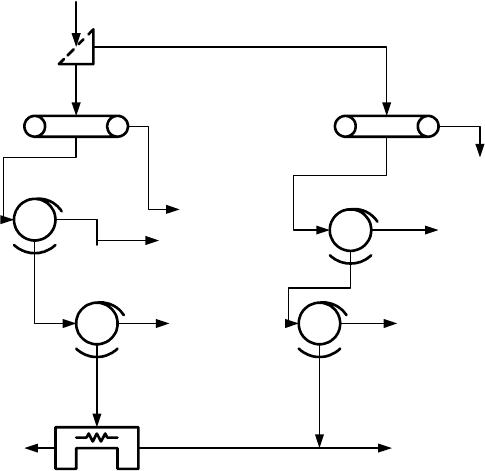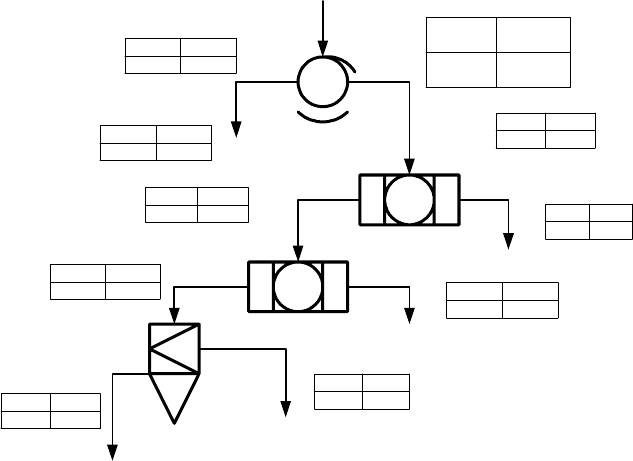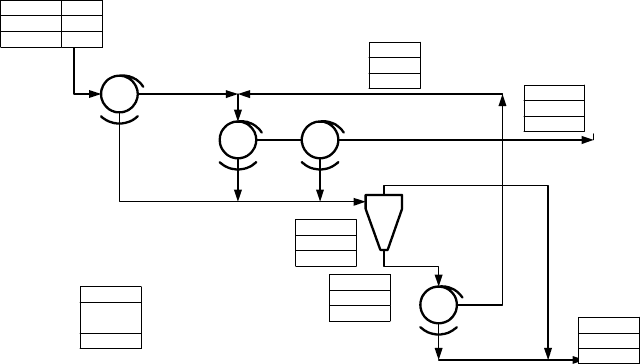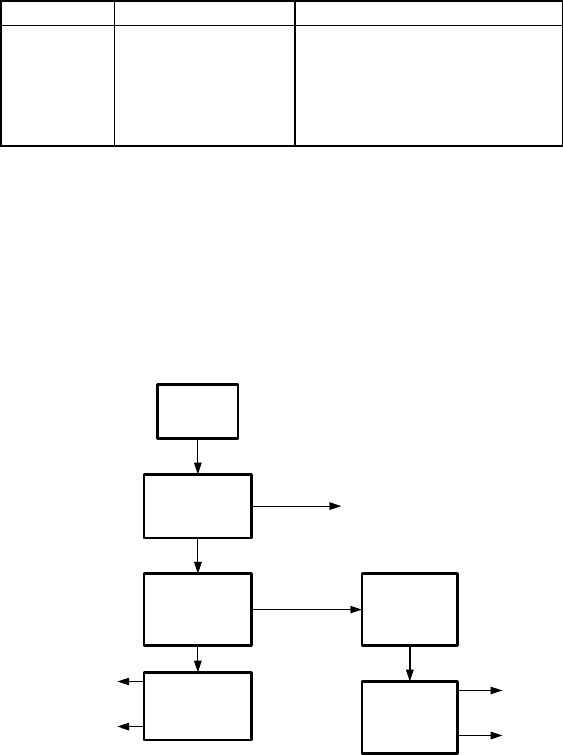Jan Svoboda. Magnetic Techniques for the Treatment of Materials
Подождите немного. Документ загружается.


490 CHAPTER 6. INDUSTRIAL APPLICATIONS
Figure 6.25: VMS-100 separators at the Tchkalov manganese ore beneficiation
plant (the Ukraine), (courtesy of Ore Research Institute, Czech
Republic).
spirals and electrostatic separators. The fine fraction (- 45 m) was discarded
for the lack of suitable beneficiation technology. The total recovery of ilmenite
amounted to only 17% to 20%.
To increase the ilmenite recovery, a magnetic separation-flotation flowsheet
was tested and applied in production in 1997. A SLON-1500 magnetic separator
was installed as a rougher, to treat the - 45 m fraction, with a grade of 11%
TiO
2
, followed by flotation as a cleaner. The process flowsheet is shown in Fig.
6.26.
As can be seen, the ilmenite concentrate with a grade of more than 47% TiO
2
is being obtained at a recovery of 44%. In 1999 20 kt of the ilmenite concentrate
were produced from the fine fraction, and another 20 kt/a of the concentrate
were recovered from the tailings dump [X3]. After installation of four more
SLON separators to complete five ilmenite processing lines, the production has
increased to 80 kt/a.
Rooiwater ilmenite ore (South Africa)
Magnetic separation was found to be an e!cient technique for concentration of
ilmenite and for rejection of silica from Rooiwater (Limpopo Province, South
Africa) ilmenite ore, as is demonstrated in a flowsheet shown in Fig. 6.27. The
coarse fraction (+ 106 m) was upgraded from the head grade of 13% TiO
2
to
44.3% TiO
2
at an overall recovery greater than 68%. The concentration of silica
was reduced from 53.1% SiO
2
in the feed to about 7% in the final concentrate.
The role played by magnetic separation at dierent stages of the process is well

6.1. TREATMENT OF MINERALS 491
Mass, %
TiO2, %
Recovery,
% TiO2
Feed (- 45 um)
Cyclone
Slimes (- 10 um)
100
10.12
100
60.78
11.03
66.24
36.69
4.34
15.73
39.22
8.71
33.76
24.06
21.22
50.51
Mags
Non-mags
SLON-1500
Pyrite
0.65
12.57
0.81
Sulphide flotation
30.26
21.71
64.91
6.82
22.57
15.21
Ilmenite flotation
rougher
Ilmenite flotation
cleaner
Ilmenite flotation
scavenger
12.53
42.87
53.08
2.96
28.35
8.29
9.57
47.36
44.79
Ilmenite concentrate
89.78
6.13
54.40
Tailings
Legend
Figure 6.26: Flowsheet for the treatment of - 45 m ilmenite fraction at Pang
Zhi Hua, China (adapted from [X3]).

492 CHAPTER 6. INDUSTRIAL APPLICATIONS
Feed (-106 um)
Mags
REDS, 0.4 T
WHIMS 1
WHIMS 2
WHIMS 3
WHIMS 4
Ilmenite concentrate
Tailings
Non-mags
Non-mags
Non-mags
Non-mags
Mags
Mags
Mags
13.0
53.1
100
Non-mags
11.7
57.7
81.7
26.75
5.62
18.3
30.62
23.84
96.0
0.89
76.95
4.0
39.4
12.2
95.5
5.3
56.4
4.5
43.6
8.8
90.0
21.3
32.5
9.1
44.3
7.2
47.0
43.4
7.7
53.0
Grade, %
TiO2
% SiO2
Recovery,
% TiO2
Legend
Figure 6.27: Flowsheet for the treatment of + 106 m fraction of the Rooiwater
ilmenite sands by magnetic separation.

6.1. TREATMENT OF MINERALS 493
HMC feed
+ 500 um
- 500 um
Belt magnetic
separator
Mags
Non-mags
Mags
Non-mags
Non-mags
Mags
Electrostatic separator
Non-conductors
Conductors
To smelter
Mags
Non-mags
Non-mags
Mags
Non-mags
Mags
Belt magnetic
separator
REDS
REDS
REDS
REDS
Figure 6.28: Dry magnetic separation flowsheet for the beneficiation of the Rooi-
water ilmenite ore (adapted from [E7]).
demonstrated. Since wet high-intensity magnetic separation failed to produce
smelter-quality ilmenite concentrate, mainly because of a high concentration
of silica, dry magnetic beneficiation was investigated [E7]. Figure 6.28 shows
the dry beneficiation flowsheet applied to the treatment of the heavy mineral
concentrate, assaying 43% TiO
2
and6%to8%SiO
2
. Rare-earth drum magnetic
separators were used in two stages. The grade of the combined + 500 m
magnetic fraction and - 500 m conductors from electrostatic separators was
48.5% to 50.0% TiO
2
andlessthan1%SiO
2
. The overall recovery of TiO
2
was
greater than 90%.
The grade of the fine fraction - 106 m was increased from 9.5% TiO
2
in
the feed to 42.1% TiO
2
in the final concentrate, while silica was rejected from
47.9% SiO
2
to about 9.6% in the concentrate.
A hard ore from another Rooiwater deposit was upgraded using a combina-
tion of WHIMS and spirals, as can be seen in the flowsheet shown in Fig. 6.29.
The grade of the final ilmenite concentrate was 44.69% TiO
2
and 0.40% SiO
2
at an overall TiO
2
recovery of 50%.

494 CHAPTER 6. INDUSTRIAL APPLICATIONS
Feed: - 0.6 mm
Grade
TiO2
Grade
SiO2
Recovery
TiO2
Recovery
SiO2
Legend
28.71 22.4
100 100
26.14 1.66
17.20 1.40
29.31 23.51
82.80 98.60
11.87 55.88
13.33 93.69
40.83 2.25
69.47 4.91
30.14 12.75
9.62 3.17
43.30 0.98
59.85 1.74
37.41 3.96
9.88 1.17
44.69 0.40
49.97 0.57
Ilmenite concentrate
Tailings
Spiral
WHIMS 2
Non-mags
Mags
WHIMS 1
Mags
Non-mags
Mags
Non-mags
LIMS
Figure 6.29: Flowsheet for the treatment of the - 0.6 mm fraction of the Rooi-
water ilmenite ore by magnetic separation.
6.1.6 Beneficiation of ores of non-ferrous metals
Boliden Mineral AB, Sweden
Boliden Mineral AB is a producer of concentrates of sulphide minerals and base
metals. The metals are recovered, as a rule, by flotation. However, the flotation
concentrates usually contain small concentration of other metal sulphides. The
lead concentrate, for instance, contains copper and zinc. To recover zinc lost to
the lead concentrate, a Sala carousel HGMS is used as a cleaner, as is shown in
Fig. 6.30. The non-magnetic product from the HGMS is the final lead concen-
trate, while the magnetic fraction, containing mainly sphalerite, chalcopyrite,
galena and iron-rich silicates, is further treated by flotation [W30].
It can be seen that HGMS reduces the zinc concentration in the lead con-
centrate from 10% to 6%, with little loss of silver. The removal of sphalerite
and the fact that the iron-containing silicates are also recovered, reduces the
amount of material in the galena concentrate.
High-gradient magnetic separation was also successfully applied, on pilot-
plant scale, to the upgrading of complex sulphide flotation concentrates from a
Chinese beneficiation plant [Z8]. A Cu-Pb-Zn bulk flotation concentrate from a
polymetallic sulphide ore was treated in a high-gradient magnetic separator with

6.1. TREATMENT OF MINERALS 495
Cu-Pb
flotation
Cu-Pb
separation
Pb concentrate
LIMS
Trommel screen
Screen
HGMS
Thickener
Thickener
Non-mags
Mags
Waste
To Zn-Pb flotation
Grade
[%]
Recovery
[%]
Cu Cu
Zn Zn
Pb Pb
0.39 100
9.41 100
50.46 100
0.20 14.7
19.18 56.2
23.20 12.7
0.45 85.3
5.70 43.8
60.84 87.3
Figure 6.30: Flowsheet of the HGMS circuit at the Boliden Garpenberg concen-
trator, Sweden (adapted from [W30]).
From mill
LIMS rougher
LIMS cleaner
Mags
Scavenger
flotation
Aeration
Non-mags
Constant head
tank
Mill and mag sep
dilution
To flotation
Final tailings
Figure 6.31: Magnetic separation flowsheet at the Black Mountain, South
Africa, beneficiation plant (adapted from [H26]).

496 CHAPTER 6. INDUSTRIAL APPLICATIONS
Table 6.4: HGMS of a sulphide flotation concentrate (China) [Z8].
Parameter Feed Magnetics Non-magnetics
Grade [%]
Cu 8.97 18.68 3.24
Pb 3.64 0.72 5.36
Zn 40.30 18.47 53.18
Recovery [%]
Cu 100 77.28 22.72
Pb 100 7.34 92.66
Zn 100 17.01 82.99
Table 6.5: HGMS of the black ore Pb concentrate, Dowa Mining, Japan [K28].
Parameter Feed Magnetics Non-magnetics
Grade [%]
Cu 7.6 46.8 3.2
Pb 58.2 3.5 64.3
Recovery [%]
Cu 100 62.1 37.9
Pb 100 0.6 99.4
a pulsation mechanism. Typical results of the investigation are shown in Table
6.4. It can be seen that, in one pass, the copper concentrate was upgraded from
8.79% Cu to 18.68% Cu at a recovery of 77.28% Cu. Lead was concentrated
into the non-magnetic fraction with a recovery of 92.66%, while the recovery of
zinc was 82.98%.
Pb flotation concentrate, Dowa Mining, Japan
In the flotation process of black ore, the lead concentrate contains a small
amount of unfloatable copper minerals. Kim et al. [K28] found that the Pb
flotation concentrate, containing 5% to 8% of Cu, can be upgraded by removing
copper by HGMS. The removal of copper minerals is facilitated by the relatively
high values of magnetic susceptibility of copper minerals compared to diamag-
netic galena. Typical results of the removal of copper by HGMS are summarized
in Table 6.5. It can be seen that the Cu grade in the non-magnetic Pb concen-
trate decreased from 7.6% to 3.2% while the losses of lead into the magnetic
fraction were as low as 0.6%.
Black Mountain Mineral Development Co., Aggeneys, South Africa
The concentrator of Black Mountain Mineral Development Company produces
three concentrates, namely copper, lead and zinc in a dierential flotation
process. A large portion of the Broken Hill ore body consists of magnetite

6.1. TREATMENT OF MINERALS 497
Mill 70
Cyclone 150
Overflow 1.33
Rougher LIMS
3.0
2.5
1.74
44
36
1.79
Cleaner LIMS
Mags
Non-mags
29
255
1.08
10
4
2.33
26
278.5
1.07
Magnetite
Tailings
t/h solids
m3/h
water
density
Legend
Non-mags
Mags
Scavenger LIMS
Figure 6.32: Magnetic separation plant for the recovery of vanadium from
vanadiferous magnetite (Limpopo Province, South Africa).
(20% to 30%) and pyrrhotite (10% to 15%). Since a significant amount of the
magnetic material can be removed by magnetic separation prior to flotation, a
magnetic separation plant was installed during 1990.
Inclusion of the magnetic separation circuit, shown in Fig. 6.31, allowed an
increase in the monthly milling rate of 24 kt, from 102 kt to 126 kt. As a result
of the increased tonnage milled, the concentrate production increased and the
operating costs per tonne milled decreased.
Vanadiferous magnetite ore, South Africa
A three-stage low-intensity magnetic separation circuit is used to upgrade vanad-
iferous magnetite at a beneficiation plant in Limpopo Province of South Africa.
The flowsheet of the magnetic separation plant is shown in Fig. 6.32. The size
distribution of the feed into the plant is 100% - 300 m and 35% - 74 m. The
mass recovery into the magnetic concentrate amounts to 65% while the recovery
of vanadium exceeds 97%.
Chromite gravity tailings, Üçköprü, Turkey
While most chromite ores are easily beneficiated using gravity concentration
methods, magnetic separation is usually unsuitable as a result of close values
of magnetic susceptibilities of chromite and the gangue minerals. Nevertheless,
close control of the operating conditions of a magnetic separator can result in
e!cient upgrading of the chromite tailings by removing e.g. olivine and serpen-

498 CHAPTER 6. INDUSTRIAL APPLICATIONS
%Cr2O3
% Recovery
8.95
100
WHIMS 1
Mags
Tailings 2
Tailings 1
Mags
WHIMS 3
WHIMS 2
Concentrate
39.84
77.49
3.65
3.88
Tailings 3
2.68
8.80
2.01
9.83
Figure 6.33: Flowsheet of the magnetic separation circuit for the beneficiation
of the Üçköprü chromite gravity tailings (adapted from [A37]).
tine minerals [A37]. A three-stage wet high intensity magnetic circuit, shown
in Fig. 6.33, was applied to gravity tailings assaying 8.94% Cr
2
O
3
.Aftera
roughing stage and two cleaning stages the final concentrate containing 39.84%
Cr
2
O
3
was obtained with 77.49% recovery. A combination of magnetic sepa-
ration with flotation yielded the final concentrate assaying 46.17% Cr
2
O
3
with
64% recovery [A37].
6.1.7 Mineral sands
Mineral sands deposits are mixtures of commercial minerals such as ilmenite,
rutile, leucoxene, zircon, monazite and xenotime coexisting with sub-economic
minerals such as kyanite and staurolite and gangue such as quartz and clay.
Magnetic properties of the major heavy minerals are given in Table 6.6. The
heavy minerals content of the commercially viable ore bodies varies between 5%
to 20%. The principal producers of these minerals are South Africa, Australia
and the USA.
Richards Bay Minerals, South Africa
Richards Bay Minerals (RBM) in KwaZulu-Natal Province is a major world
producer of zircon and rutile raw materials together with titanium slag produced
from ilmenite by the on-site smelter. To feed the smelter, ilmenite is produced
in a wet high-intensity magnetic separation circuit.
RBM operates two mining plants, both incorporating dredging and gravity
concentration, as is shown in Fig. 6.34. The gravity concentrate, which contains

6.1. TREATMENT OF MINERALS 499
Table 6.6: Typical values of mass magnetic susceptibility of heavy minerals.
Mineral Composition Mag. susc. [m
3
/kg]·10
7
Ilmenite FeTiO
3
11.3
Leucoxene Altered ilmenite 6.2
Rutile TiO
2
0.16
Zircon ZrSiO
4
-0.03
Monazite (Ce,La,Y,Th)PO
4
1.9
Dredge
Concentrator
Feed
preparation
Dry Mill
Roaster
Smelter
Tailings
Zircon
Rutile
TiO2 slag
Iron
Mags
Non-mags
Heavy mineral
concentrate
Figure 6.34: Mineral sand beneficiation process at Richards Bay Minerals [B34].
